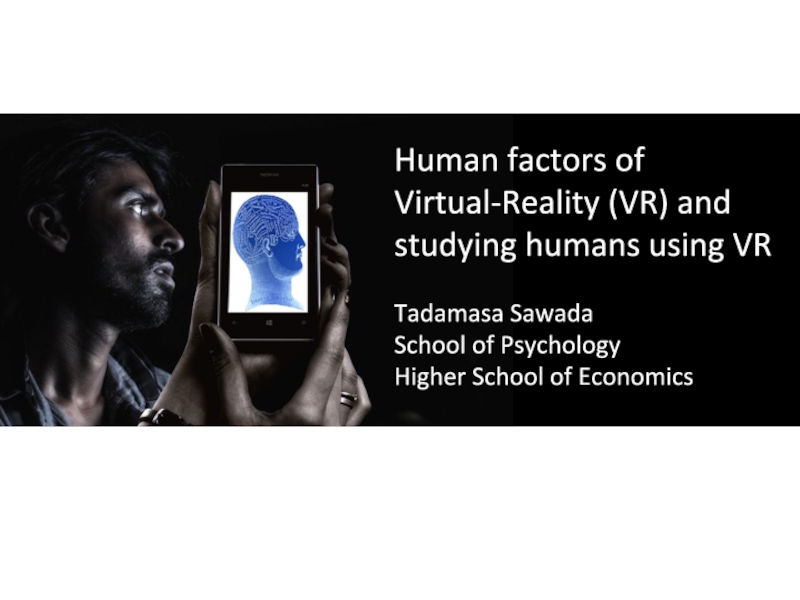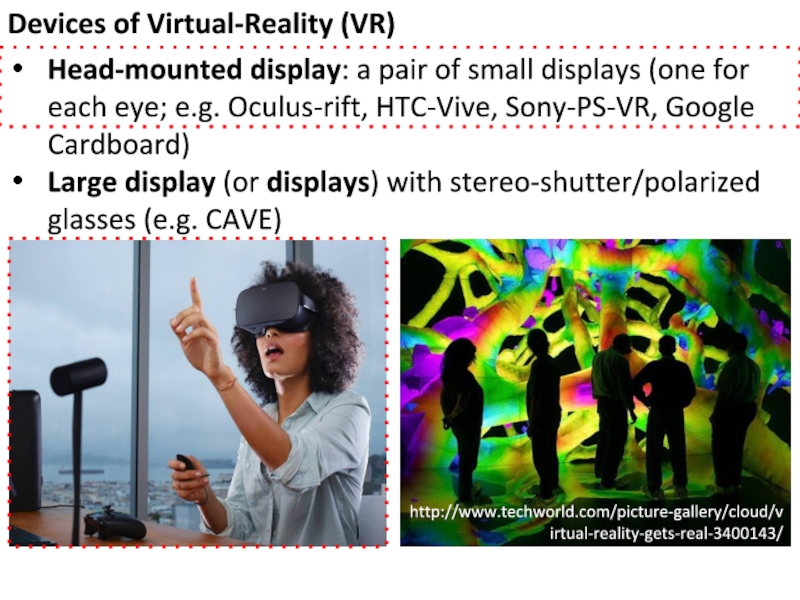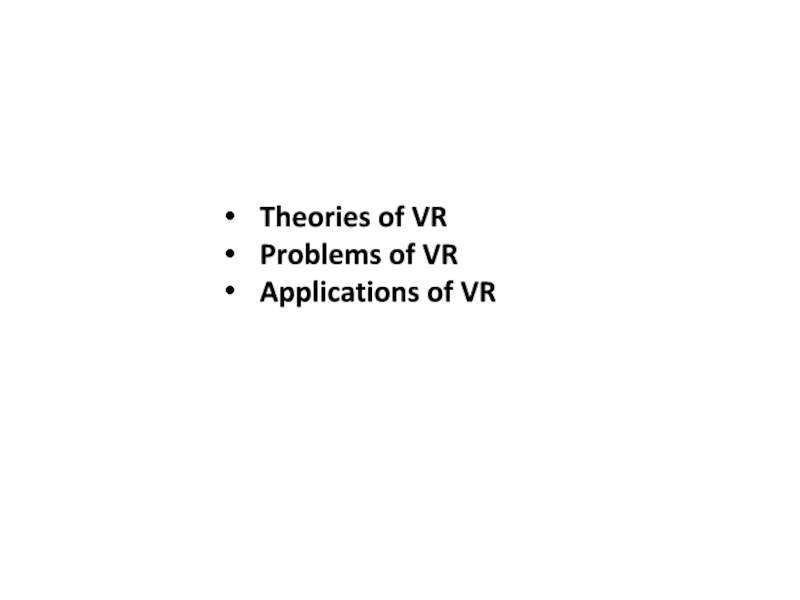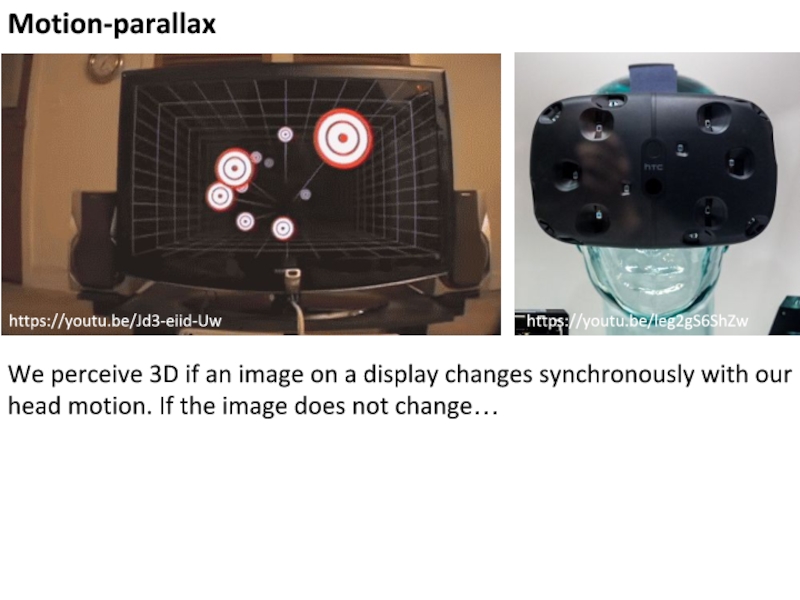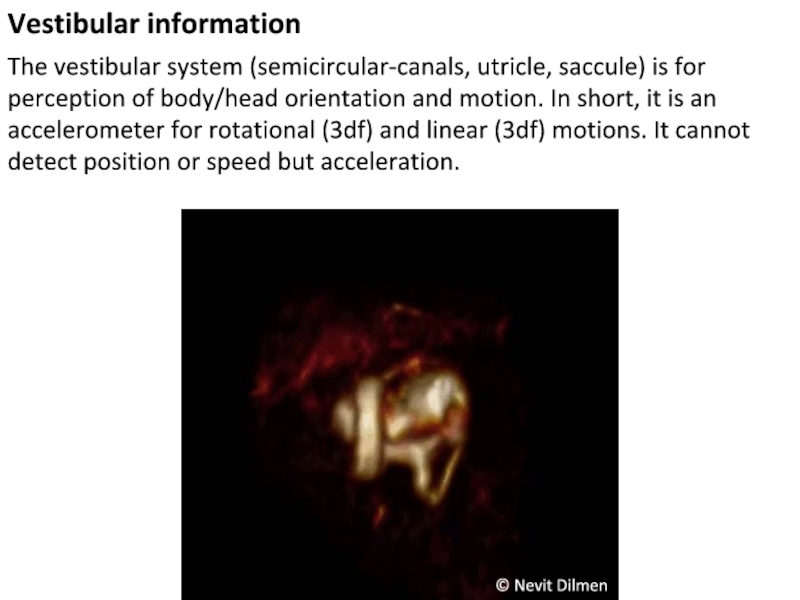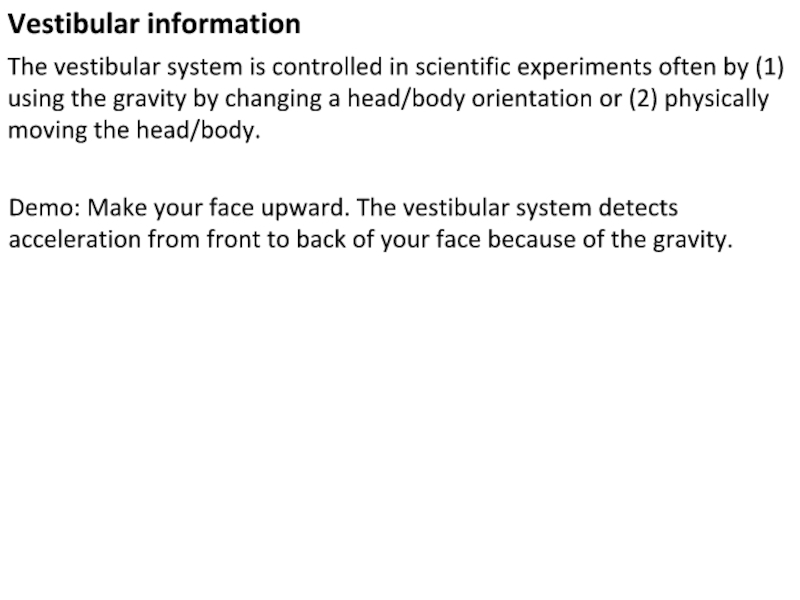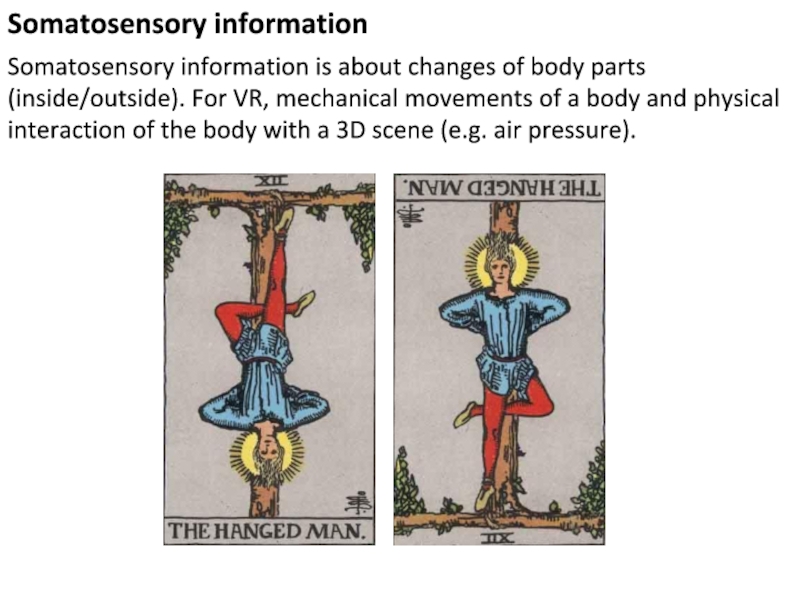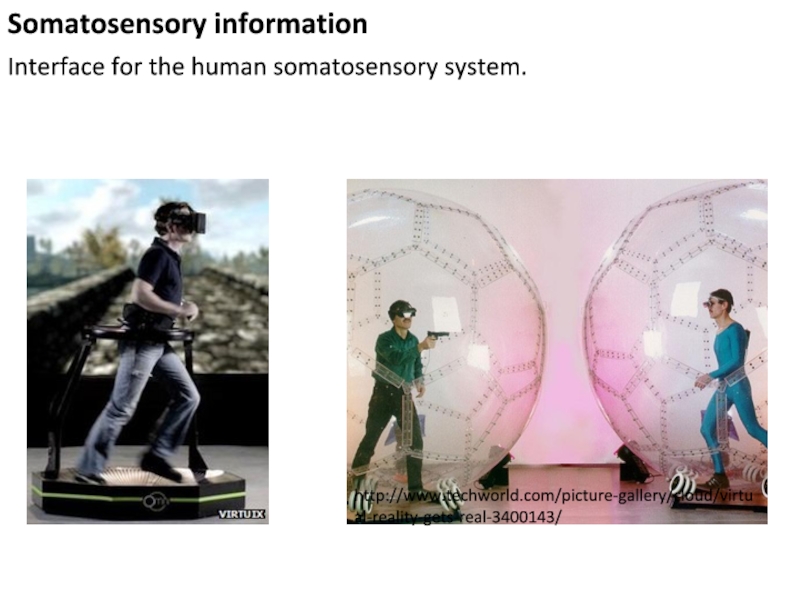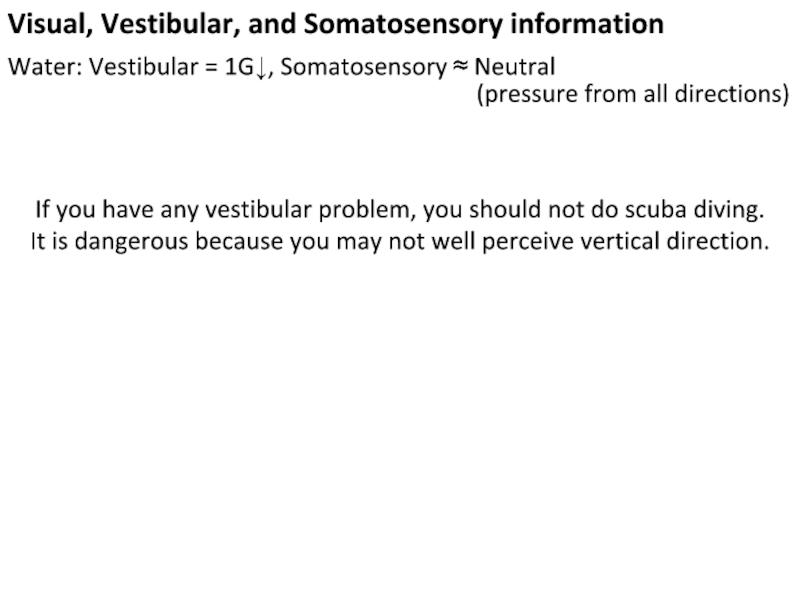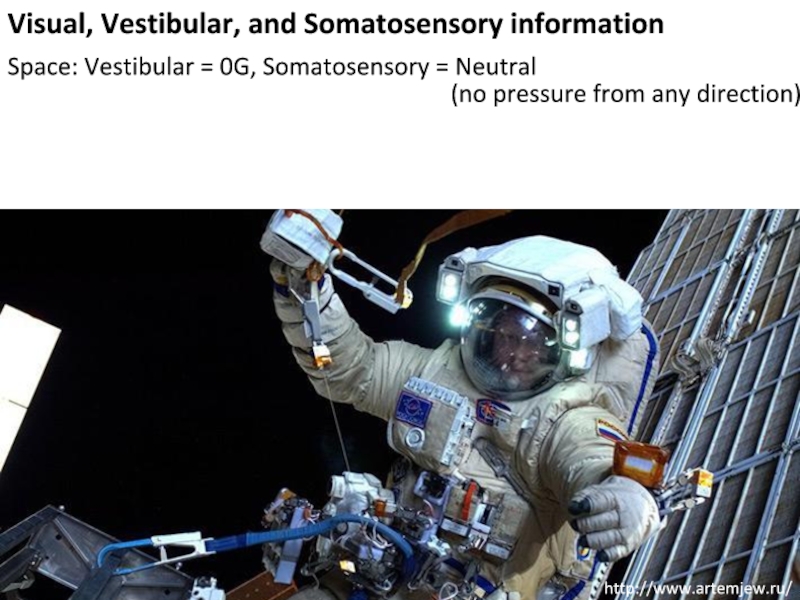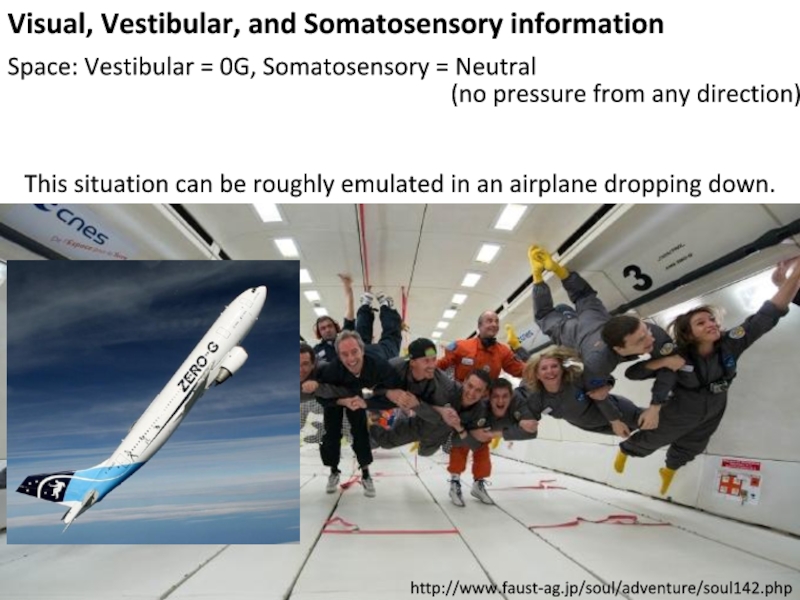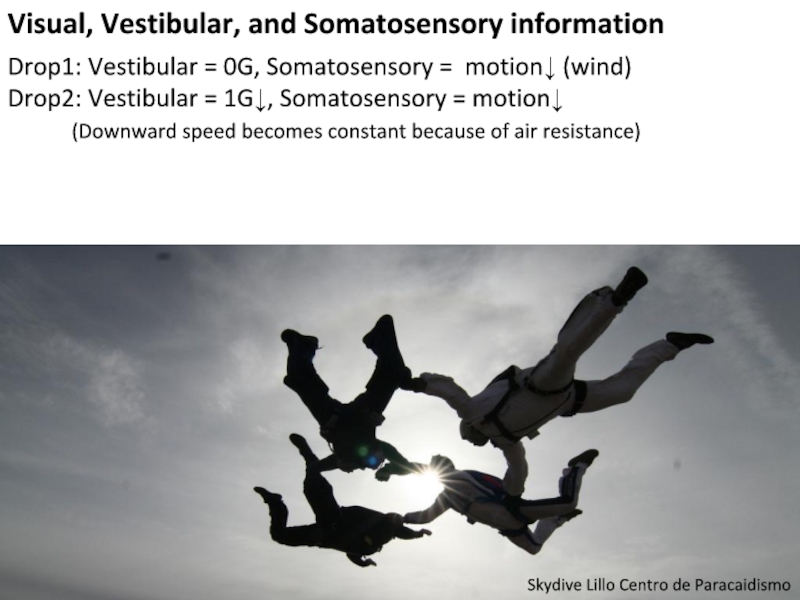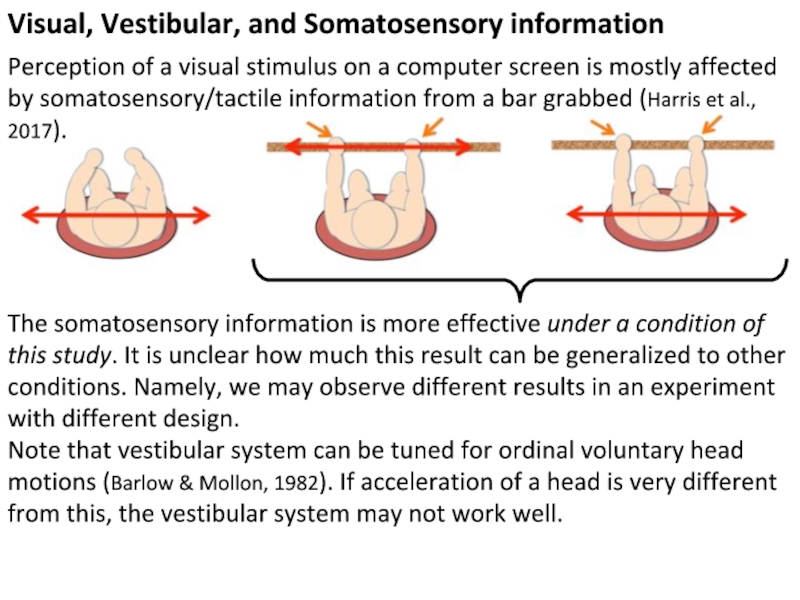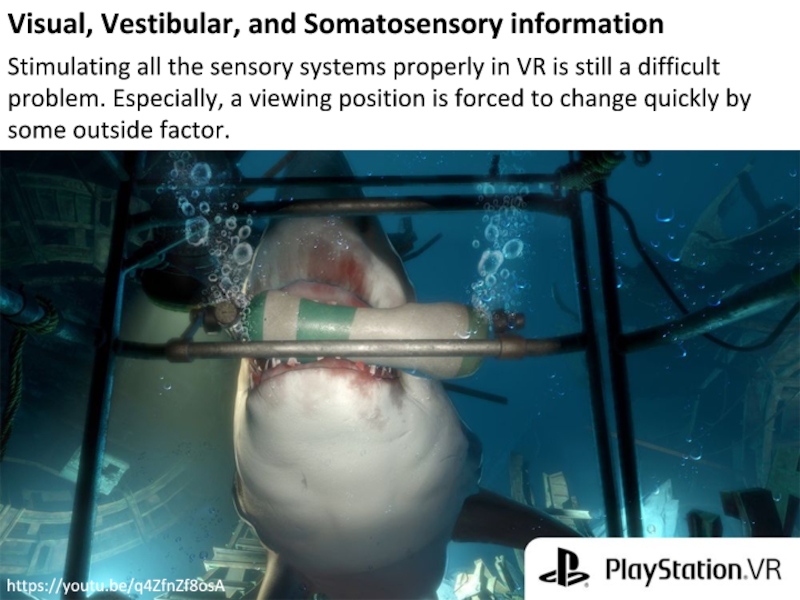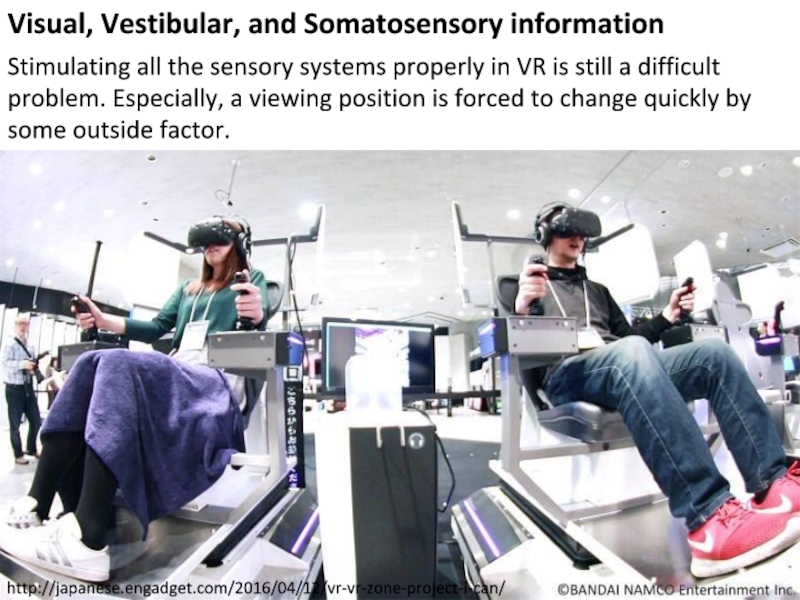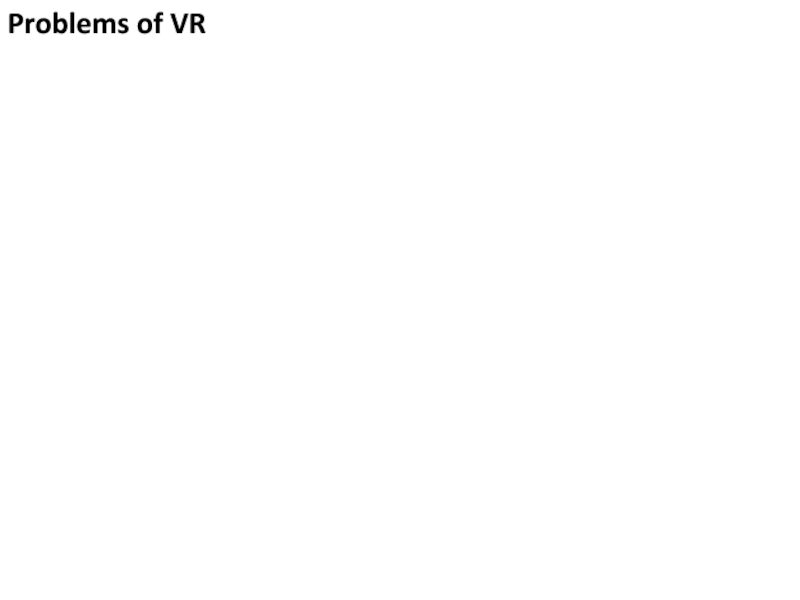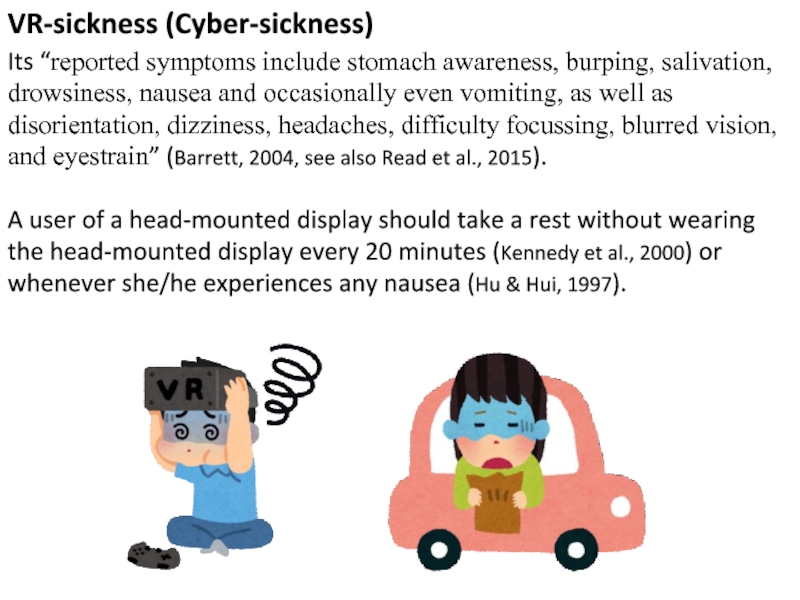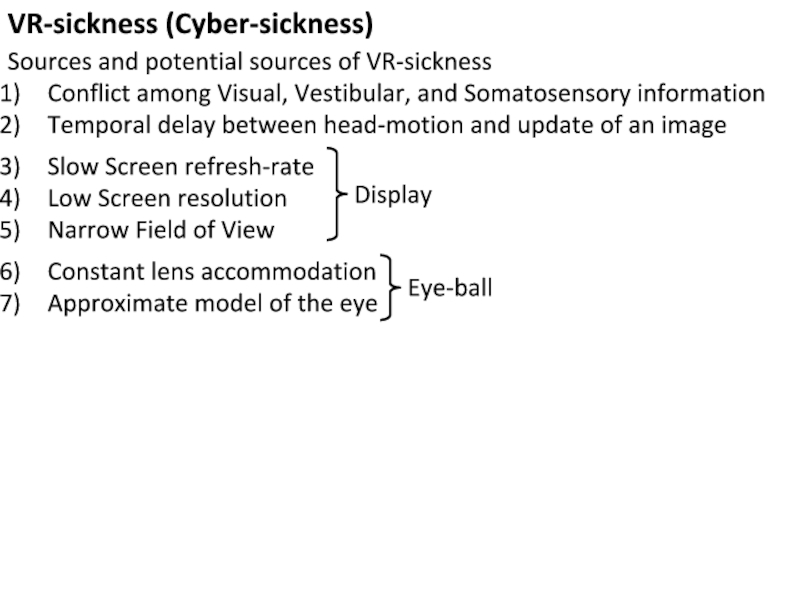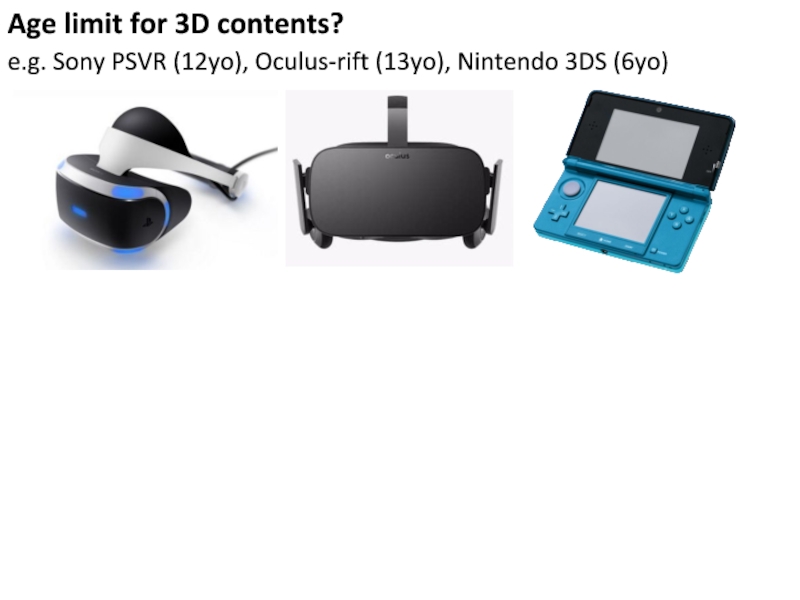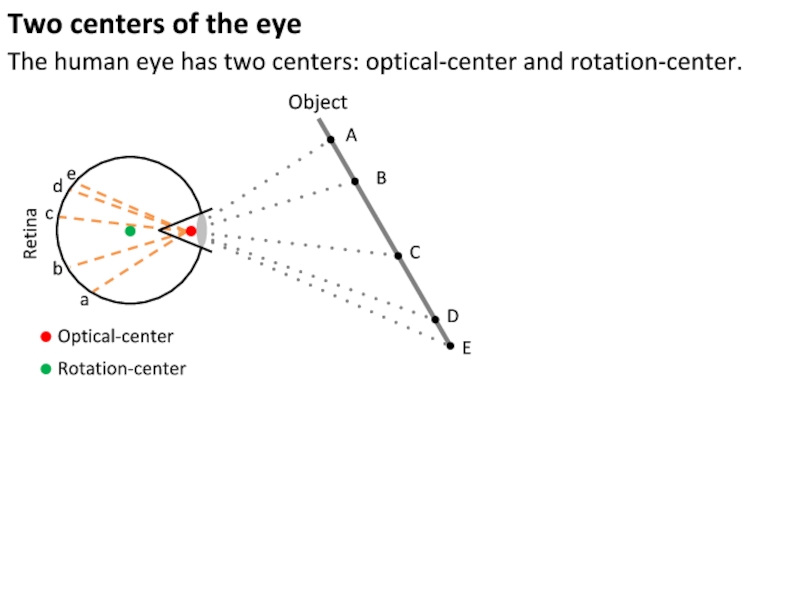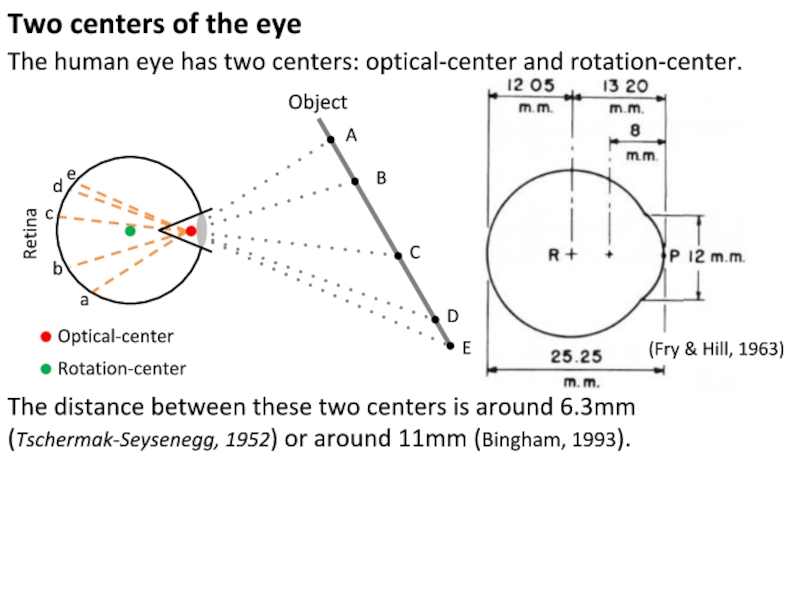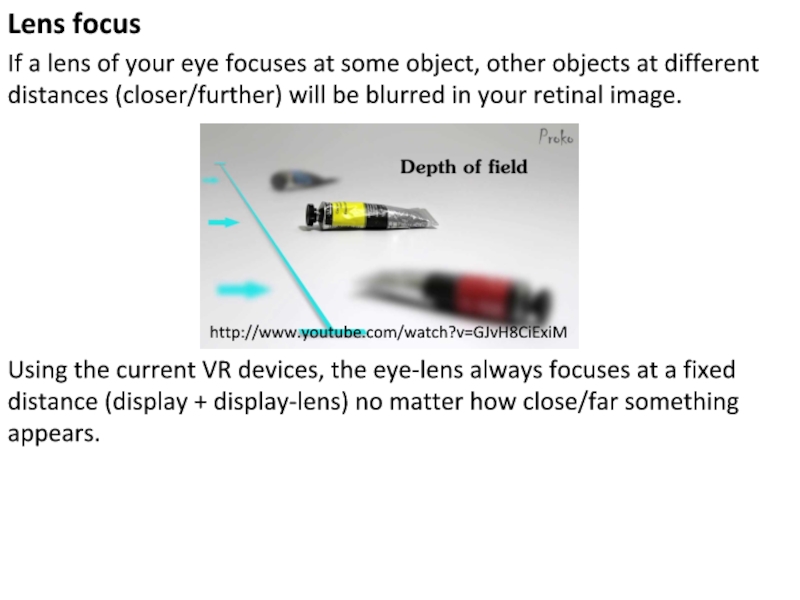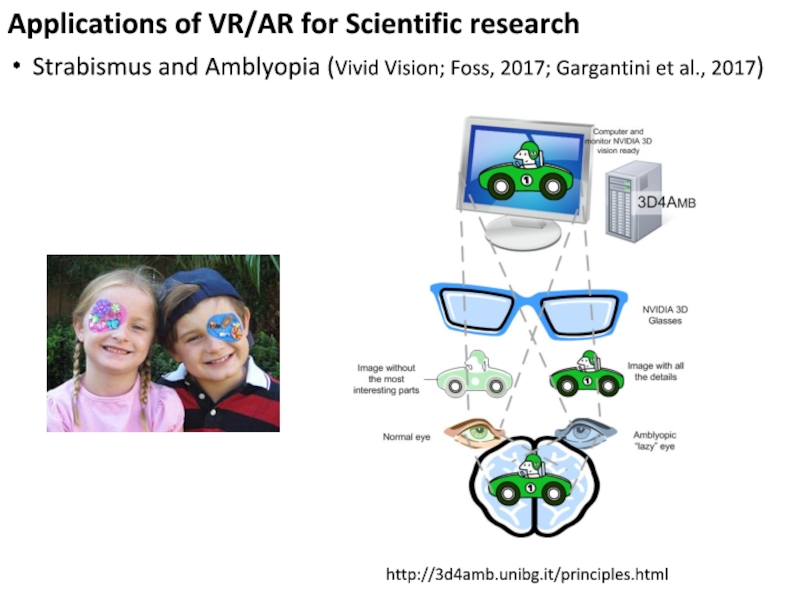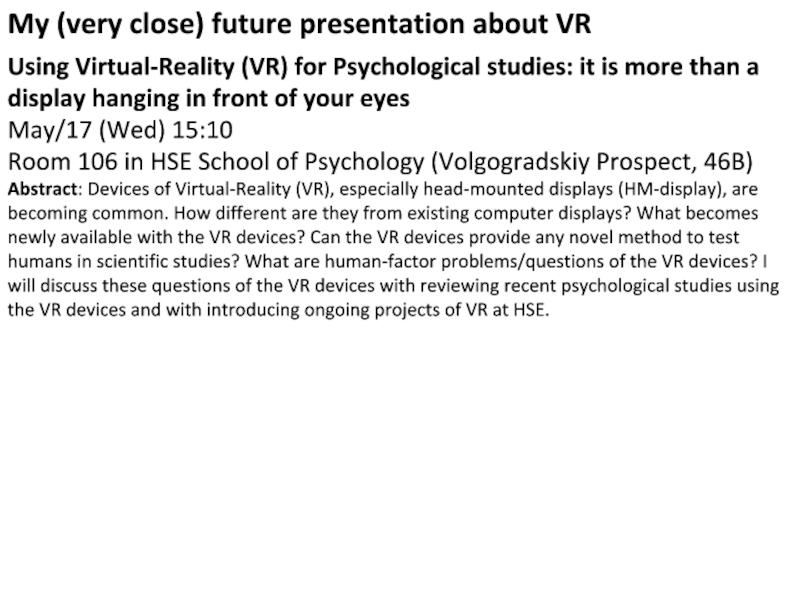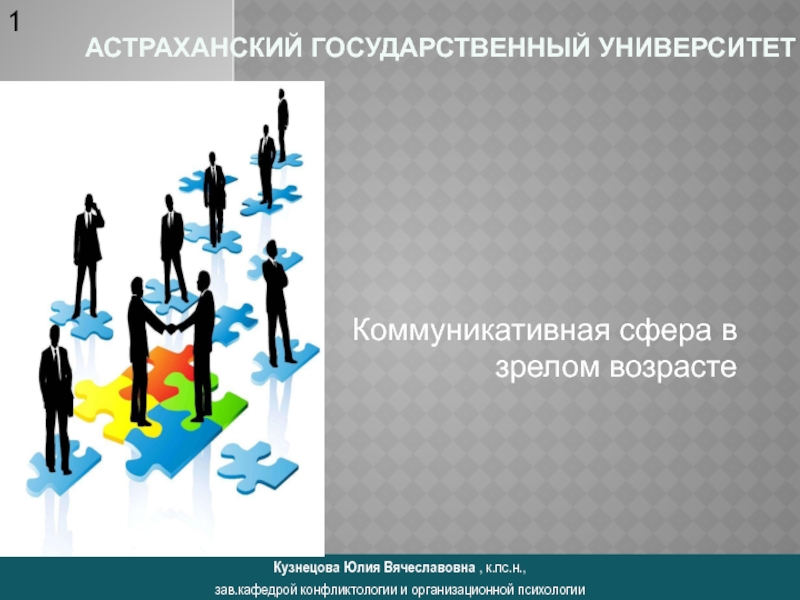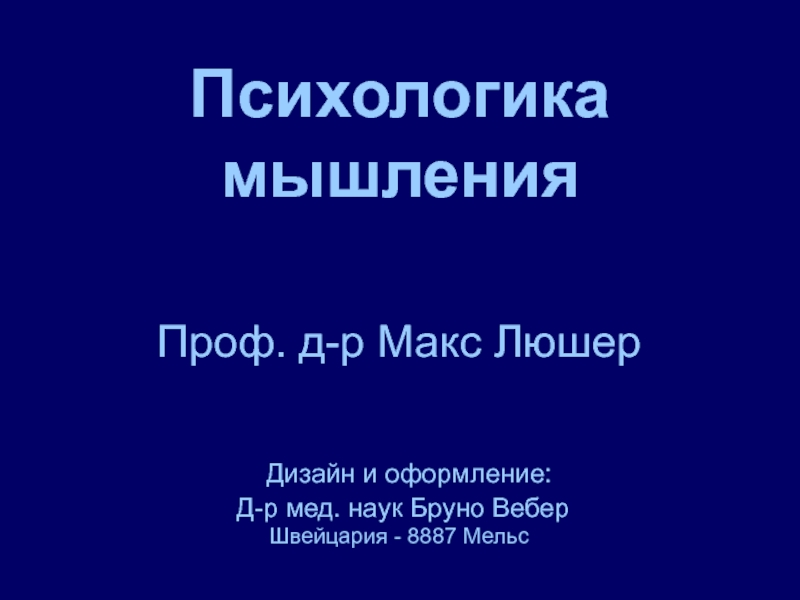- Главная
- Разное
- Дизайн
- Бизнес и предпринимательство
- Аналитика
- Образование
- Развлечения
- Красота и здоровье
- Финансы
- Государство
- Путешествия
- Спорт
- Недвижимость
- Армия
- Графика
- Культурология
- Еда и кулинария
- Лингвистика
- Английский язык
- Астрономия
- Алгебра
- Биология
- География
- Детские презентации
- Информатика
- История
- Литература
- Маркетинг
- Математика
- Медицина
- Менеджмент
- Музыка
- МХК
- Немецкий язык
- ОБЖ
- Обществознание
- Окружающий мир
- Педагогика
- Русский язык
- Технология
- Физика
- Философия
- Химия
- Шаблоны, картинки для презентаций
- Экология
- Экономика
- Юриспруденция
Human factors of Virtual-Reality (VR) and studying humans using VR презентация
Содержание
- 1. Human factors of Virtual-Reality (VR) and studying humans using VR
- 2. Devices of Virtual-Reality (VR) Head-mounted display:
- 3. Theories of VR Problems of VR Applications of VR https://en.wikipedia.org/wiki/Virtual_reality_sickness
- 4. From a Display to a VR-device Large
- 5. Large field of view A large field
- 6. Stereo (binocular-disparity) 3~14% of people are stereo-blind/-deficient
- 7. Motion-parallax https://youtu.be/Jd3-eiid-Uw https://youtu.be/leg2gS6ShZw We perceive 3D if
- 8. We perceive a correct 3D scene only
- 9. Other types of sensory information for VR
- 10. Vestibular information © Nevit Dilmen The vestibular
- 11. The vestibular system is controlled in scientific
- 12. The vestibular system can be stimulated artificially
- 13. Somatosensory information Somatosensory information is about changes
- 14. http://www.techworld.com/picture-gallery/cloud/virtual-reality-gets-real-3400143/ Somatosensory information Interface for the human somatosensory system.
- 15. Somatosensory information https://www.xataka.com/galeria/birdly-vr/2/ http://kaji-lab.jp/en/index.php?research Interface for the human somatosensory system.
- 16. Visual, Vestibular, and Somatosensory information Water:
- 17. Visual, Vestibular, and Somatosensory information Space:
- 18. Visual, Vestibular, and Somatosensory information Space:
- 19. Visual, Vestibular, and Somatosensory information Drop1:
- 20. Visual, Vestibular, and Somatosensory information Drop1:
- 21. Visual, Vestibular, and Somatosensory information http://www.ultravr.org/virtualreality/top-things-to-do-virtual-reality/
- 22. All visual, vestibular, and somatosensory (action) information
- 23. Visual, Vestibular, and Somatosensory information Perception
- 24. Visual, Vestibular, and Somatosensory information Stimulating
- 25. Visual, Vestibular, and Somatosensory information http://japanese.engadget.com/2016/04/12/vr-vr-zone-project-i-can/
- 26. Binaural recording considers shapes of the human
- 27. Binaural sound in VR? There are already some video games with Binaural sound. Auditory information
- 28. Problems of VR https://en.wikipedia.org/wiki/Virtual_reality_sickness
- 29. VR-sickness (Cyber-sickness) Its “reported symptoms include stomach
- 30. VR-sickness (Cyber-sickness) Sources and potential sources of
- 31. Display Eye-ball Sources and potential
- 32. Age limit for 3D contents? e.g. Sony PSVR (12yo), Oculus-rift (13yo), Nintendo 3DS (6yo)
- 33. At least, there is one case report
- 34. Development of the visual system interpupillary distance
- 35. Two centers of the eye The human
- 36. The human eye has two centers: optical-center
- 37. The human eye has two centers: optical-center
- 38. However, the current VR devices assume that
- 39. Lens focus If a lens of your
- 40. Lens focus If a lens of your
- 41. Photosensitive epilepsy Epileptic seizures can be induced
- 42. Applications of VR/AR
- 43. Applications of VR/AR
- 44. Applications of VR/AR for Scientific research Strabismus
- 45. Applications of VR/AR for Scientific research Psycho
- 46. Applications of VR/AR for Scientific research Phantom-limb
- 47. Talking with people in different fields…
- 48. My (very close) future presentation about VR
- 49. Спасибо! tada.masa.sawada@gmail.com tsawada@hse.ru https://www.hse.ru/en/staff/tsawada
Слайд 1
Human factors of
Virtual-Reality (VR) and
studying humans using VR
Tadamasa Sawada
School
Higher School of Economics
Слайд 2Devices of Virtual-Reality (VR)
Head-mounted display: a pair of small displays
Large display (or displays) with stereo-shutter/polarized glasses (e.g. CAVE)
http://www.techworld.com/picture-gallery/cloud/virtual-reality-gets-real-3400143/
Слайд 3Theories of VR
Problems of VR
Applications of VR
https://en.wikipedia.org/wiki/Virtual_reality_sickness
Слайд 4From a Display to a VR-device
Large Field of View
Stereo
Motion-parallax
and more…
(Movie)
(3D-Movie)
© Nabeel
Interaction
Слайд 5Large field of view
A large field of view is important for
Palmisano et al. (2015)
Väljamäe et al. (2008)
Слайд 6Stereo (binocular-disparity)
3~14% of people are stereo-blind/-deficient (Gaudia et al., 2014).
Synopter for
http://binnenland.eenvandaag.nl/radio-items/60101/ik_neem_je_mee_synopter_in_het_rijksmuseum
http://www2.aimnet.ne.jp/nakahara/3dart/3genri6.html
(Moritz von Rohr, patented by CarlZeiss, 1907)
Wijntjes et al. (2016), Koenderink, van Doorn, & Kappers (1994)
Beam-splitter
Слайд 7Motion-parallax
https://youtu.be/Jd3-eiid-Uw
https://youtu.be/leg2gS6ShZw
We perceive 3D if an image on a display changes synchronously
Слайд 8We perceive a correct 3D scene only from a correct viewing
If we change a viewing position, an image on an display should synchronously change.
Images viewed from correct/incorrect positions
Слайд 9Other types of sensory information for VR
Vestibular information
Somatosensory information
(including tactile information)
Auditory
Haptic information
Olfactory information
Gustatory information
Слайд 10Vestibular information
© Nevit Dilmen
The vestibular system (semicircular-canals, utricle, saccule) is for
Слайд 11The vestibular system is controlled in scientific experiments often by (1)
Vestibular information
Demo: Make your face upward. The vestibular system detects acceleration from front to back of your face because of the gravity.
Слайд 12The vestibular system can be stimulated artificially using Galvanic-Vestibular-Stimulation and it
Vestibular information
https://youtu.be/oefVaHDo5xg
https://youtu.be/yZ_G_zbObWU
Слайд 13Somatosensory information
Somatosensory information is about changes of body parts (inside/outside). For
Слайд 14http://www.techworld.com/picture-gallery/cloud/virtual-reality-gets-real-3400143/
Somatosensory information
Interface for the human somatosensory system.
Слайд 15Somatosensory information
https://www.xataka.com/galeria/birdly-vr/2/
http://kaji-lab.jp/en/index.php?research
Interface for the human somatosensory system.
Слайд 16Visual, Vestibular, and Somatosensory information
Water: Vestibular = 1G↓, Somatosensory ≈
(pressure from all directions)
If you have any vestibular problem, you should not do scuba diving.
It is dangerous because you may not well perceive vertical direction.
Слайд 17Visual, Vestibular, and Somatosensory information
Space: Vestibular = 0G, Somatosensory =
http://www.artemjew.ru/
(no pressure from any direction)
Слайд 18Visual, Vestibular, and Somatosensory information
Space: Vestibular = 0G, Somatosensory =
(no pressure from any direction)
http://www.faust-ag.jp/soul/adventure/soul142.php
This situation can be roughly emulated in an airplane dropping down.
Слайд 19Visual, Vestibular, and Somatosensory information
Drop1: Vestibular = 0G, Somatosensory =
Drop2: Vestibular = 1G↓, Somatosensory = motion↓
(Downward speed becomes constant because of air resistance)
Skydive Lillo Centro de Paracaidismo
Слайд 20Visual, Vestibular, and Somatosensory information
Drop1: Vestibular = 0G, Somatosensory =
Drop2: Vestibular = 1G↓, Somatosensory = motion↓
(Downward speed becomes constant because of air resistance)
Parachute1: Vestibular = x G↑, Somatosensory = motion↓ + hanged
Parachute2: Vestibular = 1G↓, Somatosensory = motion↓ + hanged
Слайд 21Visual, Vestibular, and Somatosensory information
http://www.ultravr.org/virtualreality/top-things-to-do-virtual-reality/
Drop1: Vestibular = 0G, Somatosensory =
Drop2: Vestibular = 1G↓, Somatosensory = motion↓
(Downward speed becomes constant because of air resistance)
Parachute1: Vestibular = x G↑, Somatosensory = motion↓ + hanged
Parachute2: Vestibular = 1G↓, Somatosensory = motion↓ + hanged
Слайд 22All visual, vestibular, and somatosensory (action) information contributes to perception of
Aghajan et al. (2015)
Ravassard et al. (2013)
Cushman et al. (2013)
Visual, Vestibular, and Somatosensory information
Слайд 23Visual, Vestibular, and Somatosensory information
Perception of a visual stimulus on
The somatosensory information is more effective under a condition of this study. It is unclear how much this result can be generalized to other conditions. Namely, we may observe different results in an experiment with different design.
Note that vestibular system can be tuned for ordinal voluntary head motions (Barlow & Mollon, 1982). If acceleration of a head is very different from this, the vestibular system may not work well.
Слайд 24Visual, Vestibular, and Somatosensory information
Stimulating all the sensory systems properly
https://youtu.be/q4ZfnZf8osA
Слайд 25Visual, Vestibular, and Somatosensory information
http://japanese.engadget.com/2016/04/12/vr-vr-zone-project-i-can/
Stimulating all the sensory systems properly
Слайд 26Binaural recording considers shapes of the human ears.
Auditory information
http://twogoodears.blogspot.ru/2016_03_01_archive.html
To listen to
Слайд 27Binaural sound in VR?
There are already some video games with Binaural
Auditory information
Слайд 29VR-sickness (Cyber-sickness)
Its “reported symptoms include stomach awareness, burping, salivation, drowsiness, nausea
A user of a head-mounted display should take a rest without wearing the head-mounted display every 20 minutes (Kennedy et al., 2000) or whenever she/he experiences any nausea (Hu & Hui, 1997).
Слайд 30VR-sickness (Cyber-sickness)
Sources and potential sources of VR-sickness
Conflict among Visual, Vestibular, and
Temporal delay between head-motion and update of an image
Constant lens accommodation
Approximate model of the eye
Slow Screen refresh-rate
Low Screen resolution
Narrow Field of View
Display
Eye-ball
Слайд 31
Display
Eye-ball
Sources and potential sources of VR-sickness
Conflict among Visual, Vestibular, and Somatosensory
Temporal delay between head-motion and update of an image
Constant lens accommodation
Approximate model of the eye
Slow Screen refresh-rate
Low Screen resolution
Narrow Field of View
VR-sickness (Cyber-sickness)
Problems 1) and 2) are especially critical for VR-sickness.
Problems 2), 3), 4), and 5) are very technical and are matter of time and money. These problem are getting resolved.
Problems 6) and 7) may be factors causing VR-sickness. But, they are theoretically difficult to be studied and to be resolved.
Слайд 33At least, there is one case report (Tsukuda & Murai, 1988).
http://d.hatena.ne.jp/koikesan/20140910
Age limit for 3D contents?
Strabismus is developed before 6 years old of life (Hollwich, 1983/1986).
60% of cases before 2yo and the other 40% before 6yo.
But why? We see everything with two eyes everyday!
Слайд 34Development of the visual system
interpupillary distance (mm)
Pointer (1999)
https://www.slideshare.net/GauriSShrestha/progressive-lens-measurement
Usually, the VR devices
Inter-pupillary (inter-ocular) distance increases as a person gets older.
The visual system of children should be flexible to accommodate with the growing inter-pupillary distance.
Слайд 35Two centers of the eye
The human eye has two centers: optical-center
Object
A
B
C
D
E
Optical-center
Слайд 36The human eye has two centers: optical-center and rotation-center.
Retina
Object
A
B
C
D
E
Optical-center
Rotation-center
Two centers
Слайд 37The human eye has two centers: optical-center and rotation-center.
Retina
Object
A
B
C
D
E
Optical-center
Rotation-center
(Fry &
The distance between these two centers is around 6.3mm (Tschermak-Seysenegg, 1952) or around 11mm (Bingham, 1993).
Two centers of the eye
Слайд 38However, the current VR devices assume that the distance between the
Retina
Optical-center
Rotation-center
The distance between these two centers is around 6.3mm (Tschermak-Seysenegg, 1952) or around 11mm (Bingham, 1993).
(Fry & Hill, 1963)
The human eye has two centers: optical-center and rotation-center.
Two centers of the eye
Слайд 39Lens focus
If a lens of your eye focuses at some object,
http://www.youtube.com/watch?v=GJvH8CiExiM
Using the current VR devices, the eye-lens always focuses at a fixed distance (display + display-lens) no matter how close/far something appears.
Слайд 40Lens focus
If a lens of your eye focuses at some object,
http://www.youtube.com/watch?v=GJvH8CiExiM
If the objects are placed at 2m and 5m, their images can be blurred very differently (it depends on where you focus and your pupil size).
If the objects are placed at 200m and 500m, their images will be almost equally blurred (or equally focused).
Слайд 41Photosensitive epilepsy
Epileptic seizures can be induced by image flickers. An image
https://en.wikipedia.org/wiki/Denn%C5%8D_Senshi_Porygon
http://gizmodo.com/a-grand-jury-just-called-tweeting-an-animated-gif-assau-1793477149
Слайд 44Applications of VR/AR for Scientific research
Strabismus and Amblyopia (Vivid Vision; Foss,
http://3d4amb.unibg.it/principles.html
Слайд 45Applications of VR/AR for Scientific research
Psycho exposure therapy: Phobia, PTSD, Other
http://anxietynetwork.com/content/persistent-negative-attitude-can-undo-benefits-exposure-therapy
https://www.army.mil/article/144048/Virtual_Reality_Exposure_Therapy_helps_resolve_PTSD
Слайд 46Applications of VR/AR for Scientific research
Phantom-limb (Dunn, 2017)
http://www.bbc.co.uk/news/magazine-15938103
It can be an
https://www.pinterest.com/jeffreybado/phantom-pain/
Слайд 48My (very close) future presentation about VR
Using Virtual-Reality (VR) for Psychological
May/17 (Wed) 15:10
Room 106 in HSE School of Psychology (Volgogradskiy Prospect, 46B)
Abstract: Devices of Virtual-Reality (VR), especially head-mounted displays (HM-display), are becoming common. How different are they from existing computer displays? What becomes newly available with the VR devices? Can the VR devices provide any novel method to test humans in scientific studies? What are human-factor problems/questions of the VR devices? I will discuss these questions of the VR devices with reviewing recent psychological studies using the VR devices and with introducing ongoing projects of VR at HSE.
